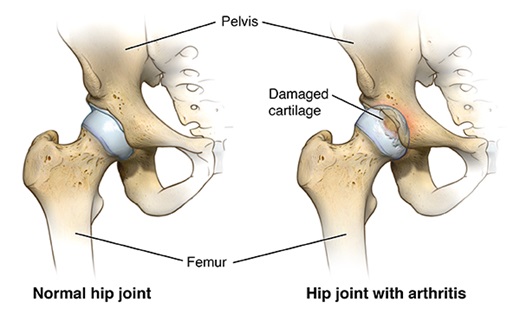When planning to have hip replacement surgery, choosing the surgeon is one of the most important decisions a patient will make. A surgeon’s training and experience can have an impact on a patient’s recovery and long-term results. The surgeon will determine where your surgical incision is located, how big it is, what type of artificial hip is implanted, and where you will go for physical therapy. What should prospective hip replacement patients do when choosing an orthopedic surgeon? Make sure to ask the following questions…

Where will the surgical incision be?
How much experience do you have with this approach? Do not be afraid to ask for specific information about your surgeon’s experience, including how many times they performed the approach of either a surgical incision at the back of the hip called the posterior approach or the side of the hip called the lateral approach or the front of the hip called the anterior approach. Research suggests that surgeons who do more than 50 hip replacements a year have the lowest complication rates. Ask your surgeon how many per year he or she has done the surgical incision on the approach he is suggesting for you.
What results should I expect after this surgery?
Studies show that nearly 90 percent of hip replacement patients feel better and resume normal activity within a few months, and sometimes even weeks, following the operation. Discuss with your surgeon specific goals and expectations you have. Question you may have are…
- Will the replacement eliminate my need for my arthritis medication??
- Will the replacement enable me to put on socks and cut my toenails?
- Will the replacement allow me to participate in my favorite sport?
- Will the replacement make sex more comfortable?
Depending on overall health expected results can vary from person to person. Understanding individual expectations can lead to greater post-surgical patient satisfaction.
What type of implant do you recommend for me?
Asking orthopedic surgeons what hip replacement is best is like going to a car show and asking people which car is best. You’ll find lots of different answers, and each person thinks they’ve got the right one. That is not to say that any individual is right or wrong, but there are many factors, and sometimes different factors, that surgeons may consider when evaluating which type of implant they prefer to use. the ball and socket component of a hip replacement can be metal, plastic (polyethylene) ceramic, or a combination of these materials. there is no definite scientific evidence showing certain hp prostheses are better than others for all patients. A surgeon will make a recommendation based on their experience and your unique situation.
What are the possible complications of this procedure?
A surgeon should be able to answer questions about how many patients get post-surgical infections, how many patients require a second surgery, and potential long-term complications. A prospective patient is encouraged to ask about past patients similar to them, who have similar risk profiles. For example, a patient who has diabetes or rheumatoid arthritis will want to know the complication rates of other patients with their specific condition.
Who will be in charge of answering my questions before and after surgery?
You should know what number to call if you have questions or concerns between appointments. You want to know with whom you can communicate. A good surgical team will provide you with detailed written materials that you can refer to at home.
What kind of physical therapy will be involved?
Before you leave the hospital, you’ll meet with a physical therapist, who will teach you strengthening and mobility exercises to do at home. It’s very important to stay active in the days and weeks after hip replacement surgery to help aid in your recovery and prevent blood clots. You should expect to do 10 to 15 minutes of exercise several times a day, every day, for about two months following your operation. In addition to doing physical therapy at home, you will probably also have one on one appointments with a physical therapist. How many times you see a physical therapist each week depends on several factors, including the surgeon’s preference, where you live, and your insurance coverage.
You should feel comfortable with a surgeon after asking these questions. If you do not feel confident feel free to get a second opinion.
We Help Patients With Hip Problems
The main cause of osteoarthritis symptoms is the breakdown of cartilage in the joints. Cartilage functions as the cushion between the bones of a joint. As the “wear and tear” of the cartilage gets worse, the joints become stiff and painful with activity. Some joints are more likely to develop osteoarthritis while others are spared. For example, osteoarthritis commonly affects the knee but not the ankle. Although there is no cure for the disease, there are effective treatments. The goals of therapy are to reduce pain and improve function.
> Learn More
For persistent joint pain that is interfering with your daily activities, see a Tristate rheumatologist to make the correct diagnosis and begin the proper treatment.
Contact Us (859-331-3100) For More Information to Request an Appointment
—
 About Tristate Arthritis and Rheumatology
About Tristate Arthritis and Rheumatology
Tristate Arthritis and Rheumatology is first and largest Rheumatology practice in the Northern Kentucky area. Founded by Dr. Arthur Kunath in 1986, our rheumatology practice now consists of six doctors who are board certified in both Internal Medicine and Rheumatology and a Physician Assistant. Patients see one doctor (except in emergencies), thereby assuring continuity of care and an individualized doctor-patient atmosphere giving the physician the ability to establish personalized and detailed relationships. Our doctors have received numerous awards, including being listed as “Top Doctors” in Cincinnati Magazine, receiving the Patient’s Choice Award, the Most Compassionate Doctor Award, and the American College of Rheumatology’s “My Doc Rocks” award.
>> Learn More


